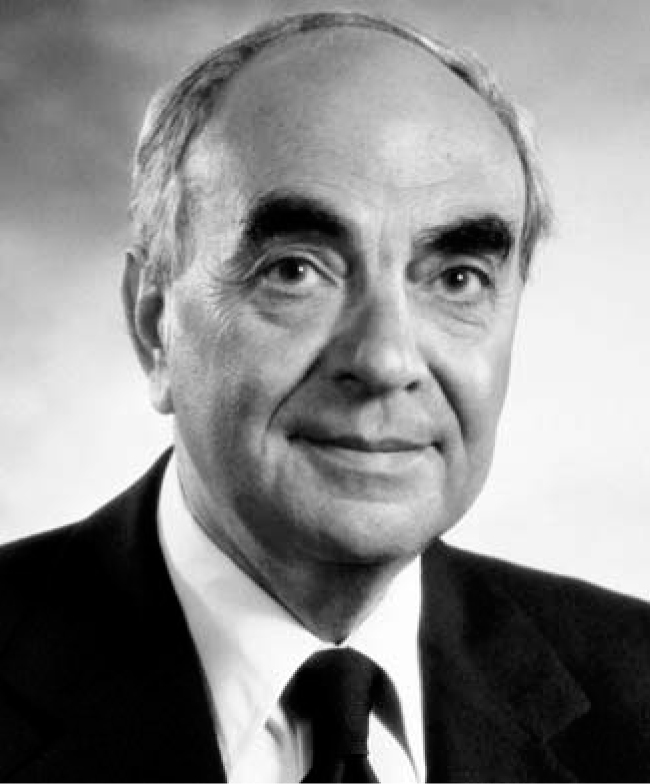David Tabor
DOI: 10.1063/1.2216974
Cambridge University physicist David Tabor died 25 November 2005. He was a humane and gentle man, yet despite his modesty he was a formidable and respected scientist. With Philip Bowden, he laid the foundation for understanding friction and lubrication and the way contacting surfaces interact.
Tabor’s parents were Jews from Lithuania, then part of the Russian empire. Anti-Semitism cost his father his job as an imperial army armorer, but a letter of recommendation from the elder Tabor’s commanding officer helped him move to London. It was there that Tabor was born 23 October 1913.
Tabor graduated from Imperial College London in 1934 and moved to Cambridge in 1936 to research under the supervision of Philip Bowden in the physical chemistry department. Their collaboration would last until Bowden’s death in 1968. At the outbreak of World War II, Bowden, who was Australian, was persuaded by the Australian government to set up a research group at Melbourne University to study practical problems associated with friction, the lubrication of bearings, and explosive initiation. Tabor, who received his PhD in physical chemistry in 1939, joined Bowden in Australia in 1940 and headed the research effort in 1945–46 while Bowden returned to Cambridge to restart his group there. Tabor met his wife Hannalene Stillschweig in wartime Australia and married her in 1943.
At Bowden’s request, Tabor conceived the name “tribophysics” (based on the Greek word tribous, meaning rubbing) to describe the Australian laboratory’s activities. The tribophysics section eventually became the Commonwealth Scientific and Industrial Research Organisation’s Division of Tribophysics in 1948, and thrived under that name until 1978 when it became the Division of Materials Science.
Tabor joined Bowden at Cambridge in 1946. At that time, Bowden’s group was still part of physical chemistry but subsequently moved to the physics department at the Cavendish Laboratory in 1958. At one stage, the group was called the physics of rubbing solids; at another, surface physics; for most of its existence, though, it has been the physics and chemistry of solids (PCS). For those fortunate enough to have researched there, it is known as PCS, and David Tabor as DT. After Bowden died, Tabor led PCS until his official retirement in 1981, although he continued as an emeritus member until his death.
Despite PCS’s various locations and name changes, its approach to research has always been to obtain physical understanding. Bowden and Tabor also saw the virtues of using an interdisciplinary team. Tabor’s first paper with Bowden, in 1939, discussed the area of contact between surfaces, and the two established the key result that the real area of contact was much smaller than the apparent area. As they emphasized, when solids make contact it is rather like turning Austria over and placing it on top of Switzerland; there is contact only at the high points. Development of that idea allowed understanding of the basic laws of friction, which had exercised scientists since Leonardo da Vinci first wrote them down.
The Bowden and Tabor volumes The Friction and Lubrication of Solids (Clarendon, 1950) and The Friction and Lubrication of Solids Part II (Clarendon, 1964) were written primarily by Tabor and are acknowledged as authoritative and fair in their attributions to both the PCS group and other researchers. Tabor’s research on contact also led to his classic book The Hardness of Metals (Clarendon), first published in 1951 and now reissued.
Though Tabor’s interest in friction was the seed for his research, his desire to understand the physics of surfaces led him and his students into many areas. They used low-energy electron diffraction (LEED) to study the atomic arrangements of atoms at surfaces. Using mica surfaces attached to crossed cylinders, Tabor’s students Richard Winterton and Jacob Israelachvili precisely measured van der Waals forces down to nanometer separations, and they subsequently used the technique for many other surface studies. Other areas of critical research included colloids, which Tabor regarded as the fourth state of matter; the diffusion of polymer chains through solids; the factors controlling rubber friction and the optimum design of car tires; and an understanding of why the friction of diamond is low but still finite. In 1992, a laboratory for the polymers and colloids group at Cavendish was named after Tabor.
On the teaching side, Tabor’s Gases, Liquids, and Solids (Penguin, 1969) has significant chapters on polymers and colloids. In his last teaching years, he offered final-year students a materials option for their major; the topics covered many areas he and his students had researched.
Tabor was elected to the Royal Society in 1963, was awarded the first tribology gold medal in 1972, received the Institute of Physics’s Guthrie Medal in 1975, and garnered a Royal Medal from the Royal Society in 1992. He was elected a foreign associate of the US National Academy of Engineering in 1995. He was also a key figure in setting up the tribology group in the IOP in 1981 and served as its first chairman.
He had a gift for languages, and he would greet foreign students in PCS and foreign delegates at conferences in their native tongue. A rough count suggests that he could welcome people in 17 languages—though on one occasion a Portuguese delegate thought he was being greeted in Spanish!
Tabor was rooted in a traditional, humane form of Judaism. For almost seven decades, he was one of the pillars of the Cambridge Jewish community. He had a great love of the biblical and rabbinical texts and a profound knowledge of Hebrew. He had a lifelong commitment to the State of Israel and the search for a just peace with the Palestinians.


More about the Authors
John Field. Cambridge University, Cambridge, UK .




